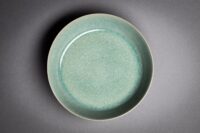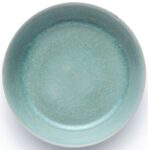 A small porcelain bowl in the collection of the Staatliche Kunstsammlungen Dresden (SKD) has been newly identified as an extremely rare piece produced by the Ru kilns of the Northern Song Dynasty (960–1127). Ru ware is the rarest of all Chinese ceramic types; this is only the 88th example of Ru pottery known in the world.
A small porcelain bowl in the collection of the Staatliche Kunstsammlungen Dresden (SKD) has been newly identified as an extremely rare piece produced by the Ru kilns of the Northern Song Dynasty (960–1127). Ru ware is the rarest of all Chinese ceramic types; this is only the 88th example of Ru pottery known in the world.
Ru was the official ware of the Northern Song dynasty. These were some of the first ceramics produced exclusively for the imperial court. It operated uniquely small kilns (no more than 6.5 feet in diameter) and production was limited because all pieces were fired individually rather than stacked and were perched on stilts. They were also fired twice, greatly increasing the odds that of failure. The Ru kilns were only in production for 20 years. The rapid decline of the late Northern Song made the Ru works a flash in the pan, but their rarity and quality exerted a massive cultural influence that has only strengthened over the centuries. Today Ru ware is revered as the pinnacle of Chinese imperial ceramic.
Five inches in diameter, the shallow bowl has rounded sides and stands on a narrow curving foot. It is a brush washer, the most popular surviving form of Ru porcelain with 34 of them known, including this one. Its translucent green-blue glaze is crazed with a pattern known as ice crackle. Ru ware was the first Chinese ceramic to embrace the faceted reflectivity of crazing as an asset. The effect is caused by the body and glaze contracting at different rates and it cannot be controlled.
The brush washer was acquired by German doctor and avid collector of Chinese porcelain Oscar Rücker-Embden when he was in China in 1913-4. He sold it to Ernst Albert Zimmermann, director of the Porzellansammlung, in 1927. While Zimmermann was a top expert on East Asian porcelain at the time, the bowl was believed to be a Korean work from the 10th-13th centuries which have very similar features and are far less rare than Ru ceramics.
 The bowl’s true identity was discovered during an exhaustive inventory of East Asian porcelains at the Porzellansammlung, the SKD’s porcelain collection. An international team of experts was enlisted to study the collection, and in 2018, staff from the Palace Museum in Beijing alerted the SKD that their “Korean” bowl might actually be a Ru piece. That has now been confirmed by Regina Krahl, one of the world’s foremost experts in Ru ware. That makes this one little bowl worth something north of $40 million. An almost identical Ru brush washer sold at Sotheby’s for $37.7 million in 2017.
The bowl’s true identity was discovered during an exhaustive inventory of East Asian porcelains at the Porzellansammlung, the SKD’s porcelain collection. An international team of experts was enlisted to study the collection, and in 2018, staff from the Palace Museum in Beijing alerted the SKD that their “Korean” bowl might actually be a Ru piece. That has now been confirmed by Regina Krahl, one of the world’s foremost experts in Ru ware. That makes this one little bowl worth something north of $40 million. An almost identical Ru brush washer sold at Sotheby’s for $37.7 million in 2017.
Julia Weber, director of the Porzellansammlung: “Of course, we knew that there are precious treasures to be found in Dresden’s Porzellansammlung, some of them little-known. But the fact that they include one of these legendary Ru ceramics is a real sensation. The bowl is one of the very first ceramics to be made exclusively for the Chinese imperial court more than 900 years ago. As the Song dynasty was driven into the south of China by invaders shortly afterwards, Ru ceramics already became a mythologised memento of an idealised lost past immediately after their creation. To this day they are considered icons of Chinese culture, though their extreme rarity means that few have the chance to admire an original, let alone own one. This history-steeped little bowl is very much at home in Dresden, where Augustus the Strong assembled the largest collection of Chinese porcelain outside Asia.”
Have you access to profile pictures of the bowl? Followed the SKD link but there was none.
It would be also interesting to see the backside of the bowl. Sometimes what is on the back can tell you even more about the history of the bowl and the way it was made.
Did the ‘press map’ really contain only one photo? Hearing about the 40m bucks, they probably did not dare to touch it any longer 😉
It may be worth annotating that Saxon king August the Strong –similar to the “Qīngliáng sì rǔ guānyáo yízhǐ”— had by 1710 his own royal factory for “Meissen” ware (a.k.a “Dresden porcelain”).
Their signature logo, the crossed swords as one of the earlier trademarks, was introduced in 1720. Thus, if the Ru bowl already had a trademark to it, its attribution would probably have been easier.
Those kilns in Korea, on the other hand, seem to have been contemporary to the Ru ones, and probably do not have trade marks on them either.